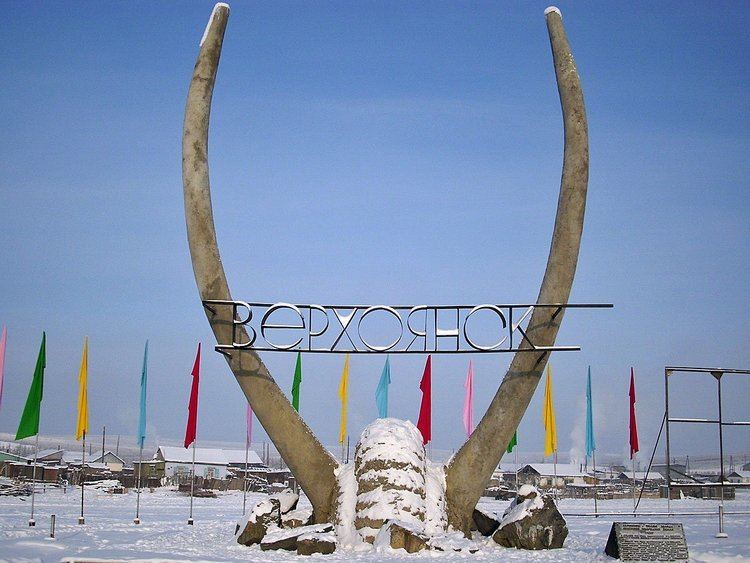Administrative district Verkhoyansky District Local time Sunday 6:55 PM | Federal subject Sakha Republic Town Verkhoyansk Founded 1638 | |
 | ||
Municipal district Verkhoyansky Municipal District Weather -1°C, Wind S at 6 km/h, 70% Humidity | ||
Verkhoyansk (Russian: Верхоянск; [vʲɪrxɐˈjansk]; Yakut: Верхоянскай, Verxoyanskay) is a town in Verkhoyansky District of the Sakha Republic, Russia, located on the Yana River near the Arctic Circle, 92 kilometers (57 mi) from Batagay, the administrative center of the district, and 675 kilometers (419 mi) north of Yakutsk, the capital of the republic. As of the 2010 Census, its population was 1,311. The town holds the Guinness world record for the greatest temperature range on Earth: 105 °C (189 °F).
Contents
- Map of Verkhoyansk Sakha Republic Russia 678530
- History
- Administrative and municipal status
- Economy
- Climate
- References
Map of Verkhoyansk, Sakha Republic, Russia, 678530
History
Cossacks founded an ostrog in 1638, 90 kilometers (56 mi) southwest of the modern town. The ostrog's name "Verkhoyansky", roughly translating from Russian as the town on the Upper Yana, derived from its geographical location on the upper reaches of the Yana River. In 1775, it was moved to the left bank of the Yana River to facilitate tax collection. It was granted town status in 1817. Between the 1860s and 1917, the town was a place of political exile, with some of the more prominent exiles including the Polish writer Wacław Sieroszewski, as well as Bolshevik revolutionaries Ivan Babushkin and Viktor Nogin.
In January 2012, the town was attacked by a pack of about four hundred wolves. According to biologists, the attack was due to a mass migration caused by a shortage in the wolves' natural food sources, in particular mountain hares. About 3,500 wolves are believed to live in the Sakha Republic; however, according to the local government, the area can realistically only support 500 wolves. Locals were forced to patrol on snowmobiles until government forces could reach the area. According to the Agriculture Ministry, wolves killed 313 horses and over 16,000 reindeer in 2012.
Administrative and municipal status
As an inhabited locality, Verkhoyansk is classified as a town under district jurisdiction. Within the framework of administrative divisions, it is incorporated within Verkhoyansky District as the Town of Verkhoyansk. As a municipal division, the Town of Verkhoyansk is incorporated within Verkhoyansky Municipal District as Verkhoyansk Urban Settlement.
Economy
There is a river port, an airport, a fur-collecting depot, and the center of a reindeer-raising area. It is also home to the Pole of Cold Museum.
Climate
Verkhoyansk is notable chiefly for its exceptionally low winter temperatures and some of the greatest temperature differences on Earth between summer and winter. Average monthly temperatures range from −45.4 °C (−49.7 °F) in January to +16.5 °C (61.7 °F) in July. Mean monthly temperatures are below freezing from October through April and exceed +10 °C (50 °F) from June through August, with the intervening months of May and September constituting very short transitional seasons. Verkhoyansk has an extreme subarctic climate (Köppen Dfd) dominated much of the year by high pressure. This has the effect of cutting off the region from warming influences in winter and together with a lack of cloud cover leads to extensive heat losses during the cooler months.
Verkhoyansk is one of the places considered the northern Pole of Cold, the other being Oymyakon. The lowest temperature recorded there, in February 1892, was −69.8 °C (−93.6 °F), recorded three days in a row on February 5, 6, and 7, along with −68.8 °C (−91.8 °F) on February 8, 1892, although there is some question as to exactly what these original measurements were. On January 1 and 15, 1885 and February 9, 1892, a temperature of −67.8 °C (−90.0 °F) was recorded: if the February 1892 readings are disregarded, these would be, together with the same reading at Oymyakon, the lowest temperature ever recorded in the Northern Hemisphere and in Asia. Only Antarctica has recorded lower temperatures: the world record temperature of −89.2 °C (−128.6 °F) was recorded at the Vostok Station in Antarctica on July 21, 1983.
In this area, temperature inversions consistently form in winter due to the extremely cold and dense air of the Siberian High pooling in deep hollows, so that temperatures increase rather than decrease with higher altitude. In Verkhoyansk it sometimes happens that the average minimum temperatures for January, February, and December are below −50 °C (−58 °F). Oymyakon and Verkhoyansk are the only two permanently populated places in the world that have recorded temperatures below −60.0 °C (−76.0 °F) every day of January.
In June, July, and August, daytime temperatures over +30 °C (86 °F) are not uncommon. The warmest month on record is July 2010, at +20.8 °C (69.4 °F). The average annual temperature for Verkhoyansk is −14.5 °C (5.9 °F). On July 25, 1988, Verkhoyansk recorded a temperature of +37.3 °C (99.1 °F), yielding a temperature range of 105 °C (189 °F) based on reliable records, which is the greatest temperature range in the world. Oymyakon and Yakutsk are the only other places in the world with a temperature range higher than 100 °C (180 °F). Verkhoyansk has never recorded a temperature above freezing between November 10 and March 14.
Verkhoyansk has a dry climate with little rainfall or snowfall: the average annual precipitation is 180 millimeters (7.1 in). Although no month can be described as truly wet, there are strong seasonal differences in precipitation, with the summer being much wetter than the winter. Winter precipitation is extremely light, largely because of the dominance of high pressure at this time of year. Snow is actually most likely in October and May, when the weather is less dry than in winter.
